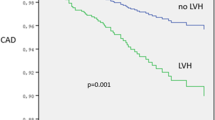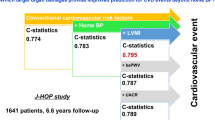Abstract
This study was undertaken to evaluate the relationships among left ventricular (LV) geometric patterns and urinary albumin excretion in patients with hypertension and electrocardiographic (ECG) LV hypertrophy. In 143 patients with stage II–III hypertension, 24-h ambulatory blood pressure (BP) monitoring, single urine albumin determination, and echocardiography were performed after 14 days of placebo treatment. Mean age was 68±7 years, 35% were women, body mass index was 28±5 kg/m2, LV mass index (LVMI) was 125±26 g/m2, and 24% had microalbuminuria. The mean office BP was 176±15/99±8 mmHg and the mean daytime ambulatory BP was 161±18/92±12 mmHg. Ambulatory BP, but not office BP, was higher among albuminuric compared to normoalbuminuric patients. In patients with established hypertension, daytime pulse pressure and office BP were different in the four patterns of LV geometry, with the highest pressure in those with abnormal geometry. Furthermore, microalbuminuria was more frequent in hypertensive patients with LV hypertrophy than in those with either normal geometry or concentric remodelling. White coat hypertensives (10%) showed lower LVMI and no microalbuminuria compared to patients with established hypertension. There were no differences in the prevalence of nondippers (26%) among the four LV geometric patterns or in microalbuminuria. In conclusion, increased daytime pulse pressure and office BP were associated with increased prevalence of abnormal LV geometry. Microalbuminuria was more frequent in groups with concentric and eccentric LV hypertrophy. Ambulatory BP, but not office BP, was higher in albuminuric than normoalbuminuric patients. With regard to the relationship among BP, LV geometric patterns, and urine albumin excretion in this population, 24-h ambulatory BP did not provide additional information beyond the office BP.
This is a preview of subscription content, access via your institution
Access options
Subscribe to this journal
Receive 12 digital issues and online access to articles
$119.00 per year
only $9.92 per issue
Buy this article
- Purchase on Springer Link
- Instant access to full article PDF
Prices may be subject to local taxes which are calculated during checkout
Similar content being viewed by others
References
Levy D et al. Prognostic implications of echocardiographically determined left ventricular mass in the Framingham Heart Study. N Engl J Med 1990; 322: 1561–1566.
Ljungman S, Wikstrand J, Hartford M, Berglund G . Urinary albumin excretion—a predictor of risk of cardiovascular disease. A prospective 10-year follow-up of middle-aged nondiabetic normal and hypertensive men. Am J Hypertens 1996; 9: 770–778.
Drayer JI, Weber MA, DeYoung JL . BP as a determinant of cardiac left ventricular mass. Arch Intern Med 1983; 143: 90–92.
Mimran A, Ribstein J, Du Cailar G . Microalbuminuria in essential hypertension. Curr Opin Nephrol Hypertens 1999; 8(3): 359–363.
White WB, Schulman P, McCabe EJ, Dey HM . Average daily blood pressure, not office blood pressure, determines cardiac function in patients with hypertension. JAMA 1989; 261: 873–877.
Koren MJ et al. Relation of left ventricular mass and geometry to morbidity and mortality in uncomplicated essential hypertension. Ann Intern Med 1991; 114: 345–352.
Ganau A et al. Patterns of left ventricular hypertrophy and geometric remodeling in essential hypertension. J Am Coll Cardiol 1992; 19: 1550–1558.
Di Tullio MR et al. Left ventricular mass and geometry and the risk of ischemic stroke. Stroke 2003; 34: 2380–2386.
James MA, Fotherby MD, Potter JF . Clinical correlates of left ventricular mass in elderly hypertensives. J Hum Hypertens 1994; 8(6): 409–415.
Dahlöf B et al. The Losartan Intervention For Endpoint reduction (LIFE) in hypertension study. Rationale, design and methods. Losartan Intervention For Endpoint Reduction in Hypertension. Am J Hypertens 1997; 10: 705–713.
Dahlöf B, for the LIFE study group et al. Cardiovascular morbidity and mortality in the Losartan Intervention for Endpoint reduction in hypertension study (LIFE): a randomised trial against atenolol. Lancet 2002; 359: 995–1003.
Wachtell K et al. Impact of different partition values on prevalences of left ventricular hypertrophy and concentric geometry in a large hypertensive population: the LIFE study. Hypertension 2000; 35: 6–12.
Devereux RB et al. Echocardiographic left ventricular geometry in hypertensive patients with electrocardiographic left ventricular hypertrophy: the LIFE Study. Blood Press 2001; 10: 74–82.
Devereux RB . Echocardiographic assessment of left ventricular hypertrophy: comparison to necropsy findings. Am J Cardiol 1986; 57: 450–458.
Imai Y et al. The accuracy and performance of the A&D TM 2421, a new ambulatory blood pressure monitoring device based on the cuff-oscillometric method and the Korotkoff sound technique. Am J Hypertens 1992; 5: 719–726.
Modesti PA et al. Clinical evaluation of the QuietTrak blood pressure recorder according to the protocol of the British Hypertension Society. Blood Press Monit 1996; 1: 63–68.
Llabre MM et al. How many blood pressure measurements are enough? An application of generalizability theory to the study of blood pressure reliability. Psychophysiology 1988; 25: 97–106.
Wiinberg N et al. 24-h ambulatory blood pressure in 352 normal Danish subjects, related to age and gender. Am J Hypertens 1995; 8: 978–986.
Verdecchia P et al. Ambulatory blood pressure. An independent predictor of prognosis in essential hypertension. Hypertension 1994; 24: 793–801.
Sahn DJ, DeMaria A, Kisslo J, Weyman A . Recommendations regarding quantitation in M-mode echocardiography: results of a survey of echocardiographic measurements. Circulation 1978; 58(6): 1072–1083.
Schiller NB et al. Recommendations for quantitation of the left ventricle by two-dimensional echocardiography. American Society of Echocardiography Committee on Standards, Subcommittee on Quantitation of Two-Dimensional Echocardiograms. J Am Soc Echocardiogr 1989; 2: 358–367.
Palmieri V et al. Reliability of echocardiographic assessment of left ventricular structure and function: the PRESERVE study. Prospective Randomized Study Evaluating Regression of Ventricular Enlargement. J Am Coll Cardiol 1999; 34: 1625–1632.
Reichek N, Devereux RB . Reliable estimation of peak left ventricular systolic pressure by M-mode echographic-determined end-diastolic relative wall thickness: identification of severe valvular aortic stenosis in adult patients. Am Heart J 1982; 103: 202–203.
Roman MJ et al. Relation of arterial structure and function to left ventricular geometric patterns in hypertensive adults. J Am Coll Cardiol 1996; 28: 751–756.
Wachtell K et al. Microalbuminuria in hypertensive patients with electrocardiographic left ventricular hypertrophy: the LIFE study. J Hypertens 2002; 20: 405–412.
Jensen JS et al. Microalbuminuria and its relation to cardiovascular disease and risk factors. A population-based study of 1254 hypertensive individuals. J Hum Hypertens 1997; 11: 727–732.
Mikkelsen KL et al. Smoking related to 24-h ambulatory blood pressure and heart rate. A study in 352 normotensive Danish subjects. Am J Hypertens 1996; 10: 483–491.
Høegholm A et al. Left ventricular mass and geometry in patients with established hypertension and white coat hypertension. Am J Hypertens 1993; 6: 282–286.
Okin PM, Roman MJ, Devereux RB, Kligfield P . Electrocardiographic identification of left ventricular hypertrophy: test performance in relation to definition of hypertrophy and presence of obesity. J Am Coll Cardiol 1996; 27: 124–131.
Pontremoli R et al. Left ventricular geometry and function in patients with essential hypertension and microalbuminuria. J Hypertens 1999; 17: 993–1000.
Wachtell K et al. Urine albumin/creatinine ratio and echocardiographic left ventricular structure and function in hypertensive patients with electrocardiographic left ventricular hypertrophy: the LIFE study. Losartan Intervention for Endpoint Reduction. Am Heart J 2002; 143(2): 319–326.
Høegholm A et al. Microalbuminuria in 411 untreated individuals with established hypertension, white coat hypertension, and normotension. Hypertension 1994; 24: 101–105.
Høegholm A, Kristensen KS, Madsen NH, Svendsen TL . White coat hypertension diagnosed by 24-h ambulatory monitoring. Examination of 159 newly diagnosed hypertensive patients. Am J Hypertens 1992; 5: 64–70.
Roman MJ et al. Association of carotid atherosclerosis and left ventricular hypertrophy. J Am Coll Cardiol 1995; 25: 83–90.
Mancia G, Omboni S, Parati G, Trazzi S . Twenty-four hour blood pressure monitoring and end-organ damage. Blood Press Suppl 1992; 1: 38–41.
Verdecchia P et al. Sex, cardiac hypertrophy and diurnal blood pressure variations in essential hypertension. J Hypertens 1992; 10: 683–692.
Author information
Authors and Affiliations
Corresponding author
Additional information
The study was funded in parts by grants from Merck & Co., Inc., West Point, PA, USA, and Editor, Mr and Mrs Anders Kaarsens Foundation, Copenhagen, Denmark
Rights and permissions
About this article
Cite this article
Wiinberg, N., Bang, L., Wachtell, K. et al. 24-h Ambulatory blood pressure in patients with ECG-determined left ventricular hypertrophy: left ventricular geometry and urinary albumin excretion—a LIFE substudy. J Hum Hypertens 18, 391–396 (2004). https://doi.org/10.1038/sj.jhh.1001717
Published:
Issue Date:
DOI: https://doi.org/10.1038/sj.jhh.1001717
Keywords
This article is cited by
-
Microalbuminuria in children with primary and white-coat hypertension
Pediatric Nephrology (2012)
-
Urinary albumin excretion is associated with true resistant hypertension
Journal of Human Hypertension (2010)
-
Intraindividual temporal variance of biomarkers and the definition of individualized prognosis in cardiovascular patients
Journal of Human Hypertension (2006)



